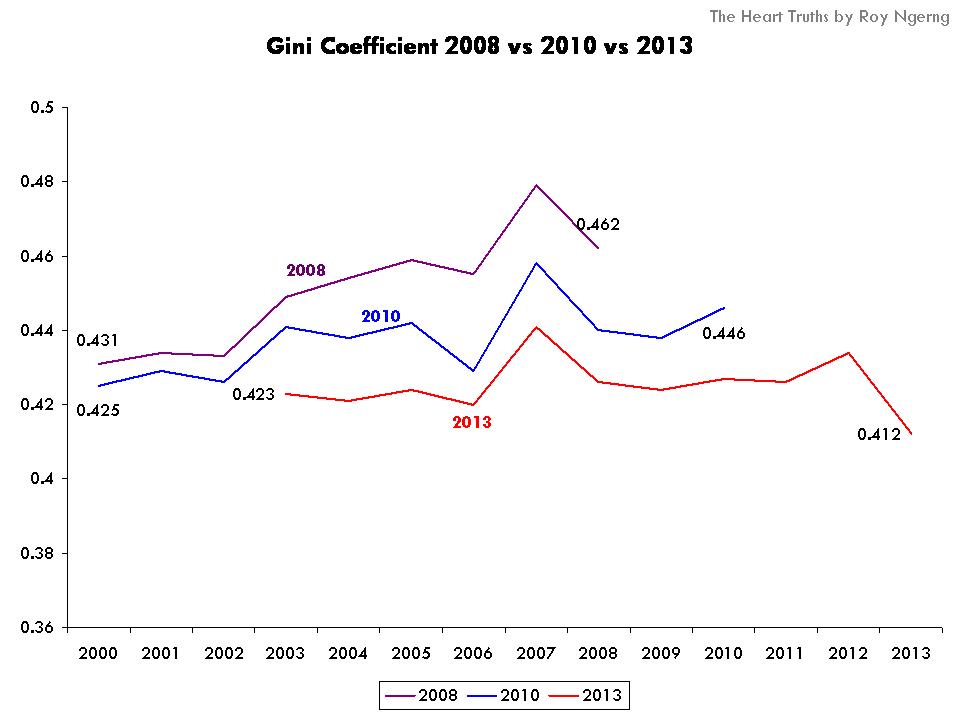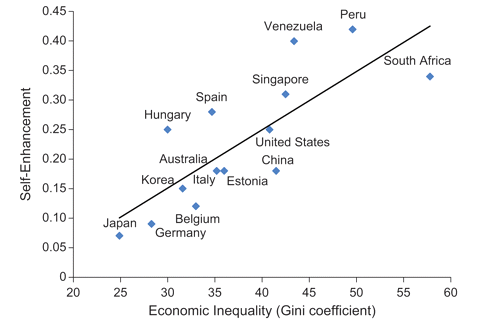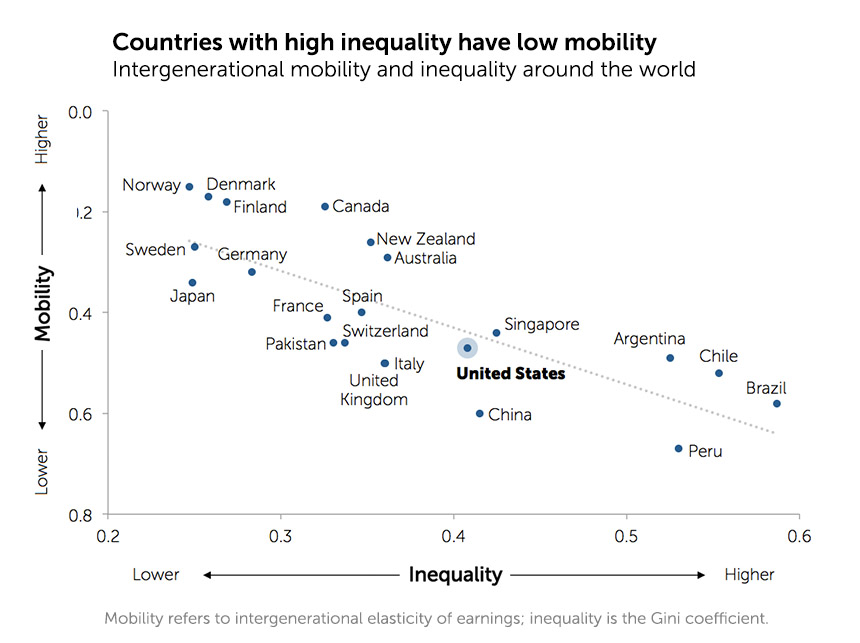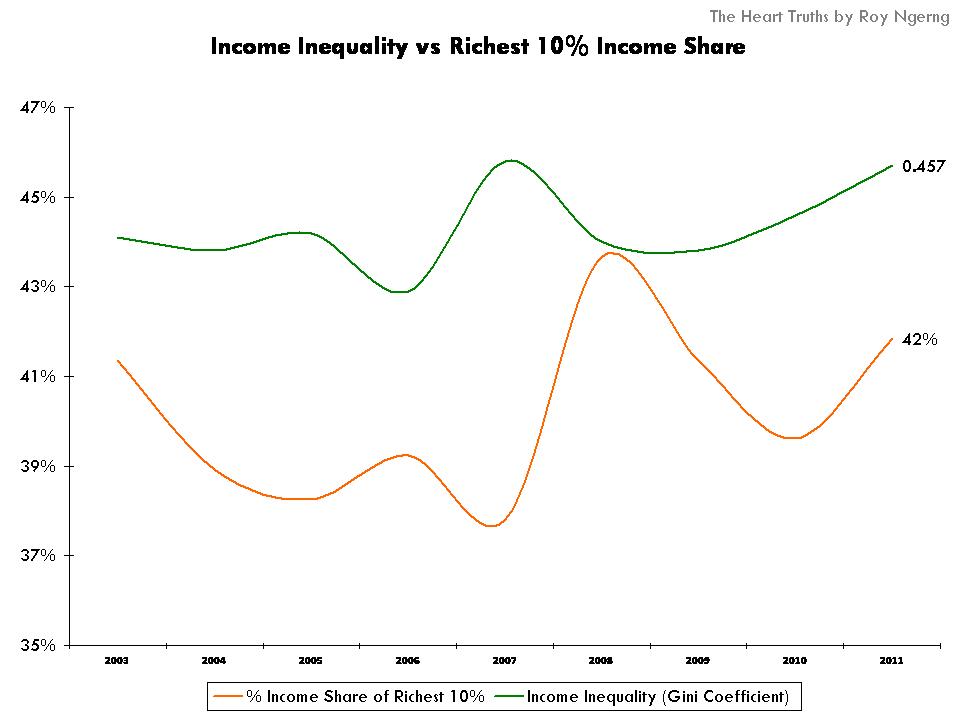We’ve caught the government!
It was reported that, “The income gap has narrowed for the first time in four years, with the Gini coefficient — a measure of income equality — falling last year to a nine-year low.“
Indeed, there was a sudden drop in the Gini coefficient in 2013 (Chart 1).
Chart 1: Key Household Income Trends, 2013
But then, on one glance, something is wrong with the chart – why is the line so flat? It didn’t used to be so flat!
So, let’s take a look at the Gini coefficient reported by the government previously.
Look at 2008:
Chart 2
Look at 2010:
Chart 3
Can you tell the difference? Don’t worry, let’s make it easier for you – you can get a clearer picture when we put all 3 statistics into the chart below:
Chart 4
Do you see what is going on? Huh, what’s happening?
The Government Drove Down the Gini Coefficient Statistics
The government has been driving down the Gini coefficient from 2008 to 2010 to 2013! In which country do you see the income inequality suddenly become lower and lower in each new report that the government puts out?
According to the footnote in the report, it was said that, “The Gini coefficient after accounting for Government transfers and taxes has been revised to incorporate improved coverage of Government taxes and transfers.”
What “improved coverage”?
Suddenly, because the government has reduced the Gini coefficient, does it mean that our lives over the past 10 years have suddenly gotten better? Do you feel better today?
The Government Flattened The Gini Coefficient
Do you also see another glaring difference?
In the 2013 Gini coefficient, the line is a lot flatter than the lines in 2008 and 2010. Suddenly, it looks like income inequality has never grown in Singapore before!
Suddenly, it looks like Singapore has been similarly equal (or similarly unequal) over the past decade!
Suddenly, the Gini Coefficient of 0.412 in the 2013 report is even lower than the Gini Coefficient of 0.431 in the 2010 report! Suddenly, Singapore is more equal in 2013 than in 2000!
Do you think things are more equal now today?
Income Inequality Is Serious: It Creates Social Problems
Now, income inequality is not a laughing matter.
High inequality comes with it a whole host of social problems.
Because Singapore has the highest income inequality among the high-income countries, there is also less trust among Singaporeans – Singapore has the lowest level of trust among the high-income countries (Chart 5).
Chart 5: The Equality Trust
Also, because the inequality has polarised Singapore, people have also become more self-centred in Singapore – “the competitiveness triggered by economic inequality” drives people to see themselves as more “superior” than another – and Singapore rates the worst off, as compared to the other high-income countries (Chart 6).
Chart 6: Deric Bownd’s Mindblog Economic inequality is linked to biased self-perception
Due to the inequality, there is low social mobility in Singapore – Singapore has one of the lowest social mobility among the high-income countries (Chart 7).
Chart 7
An adverse effect of income inequality is also that Singapore also has more prisoners – the highest among the high-income countries, after the US (Chart 8).
Chart 8: The Equality Trust
It is thus highly worrying that the government deems fit to adjust the statistics as and when they deem fit, without the relevant or corresponding explanation as to how this is done.
It is worrying because then – would we be able to have a good gauge as to how people are truly feeling in Singapore? For example, if indeed, the high inequality in Singapore has resulted in a low intergenerational social mobility, a responsible government would step in to mitigate this.
However, for the Singapore government, instead of stepping in to mitigate, has their solution been to simply tweak the statistics? Make the statistics look good, and people will naturally feel better as well.
Do you feel better?
So, how can the government be so frivolous in its definition of income inequality and how can the computation change year after year, and suddenly become lower and lower?
What exactly is this “improve coverage” that the government is talking about, and where is the computation that the government should show?
We are talking about the people’s lives here – the income inequality has a drastic effect on people’s social and psychological well-being. Just tweaking the statistics to make them look good isn’t going to improve people’s lives.
Actually IMPROVING people’s lives would improve people’s lives.
When Income Inequality Rises, The Rich Gets Richer
Meanwhile, we have already shown you that one clear effect of income inequality – not only does society become more unequal, when income inequality rises, the rich gets richer. In Chart 9, you can see that when income inequality increases (green line), the rich gets richer – their share of income increases (orange line).
Chart 9
In fact, since 1995, the richest 5% in Singapore has taken a larger and larger share on income in Singapore(Chart 10). The Singapore Prime Minister and PAP politicians belong in this category.
Chart 10
Meanwhile, the poverty rate has already been increasing in Singapore (Chart 11).
Chart 11
So wait a minute – why did the government drive down the Gini coefficient in Singapore?
Yet, why does the PAP refuses to define a poverty line? Why does Chan Chun Sing claim that, “a single poverty line to assess the family, we also risk a ‘cliff effect’.”
Why does the PAP refuses to implement a minimum wage? Why does Lim Swee Say keep championing a faulty progressive wage model, which Worker’s Party Non-Constituency Member of Parliament Gerald Giam had dispelled as being problematic as this “model” is “more intrusive and interventionist approach than a national minimum wage“, and there is a lack of transparency in how the wages are set in the “model”.
Now, income inequality is a very serious issue in Singapore – especially so when the income inequality in Singapore is highest among all the high-income countries, and when there are so many adverse effects that a highly unequal society will have, which Singapore already has.
It is no joking matter for the government to change the Gini coefficient at their whims and fancies, and not when instead of taking drastic concrete action, a “redefinition” is used to pacify the people.
Now, I ask you again – do you feel more equal today? Do you feel happier today?
If so, it will do the government well to actually understand why people are unhappy, and to deal with it instead of fudging the figures. If so, it is time the PAP government takes strong concrete actions to make Singapore more equal. Otherwise, it is as Jurong West Secondary School (JWSS) vice-principal Pushparani Nadarajah had said: ”How many of our leaders and top officers who say that every school is a good school put their children in ordinary schools near their home? (Only) until they actually do so are parents going to buy (it).”
If not, I hope Singaporeans would take care of ourselves, by doing what is right for yourself at the next general election.
Roy Ngerng
*The author blogs at www.TheHeartTruths.com











